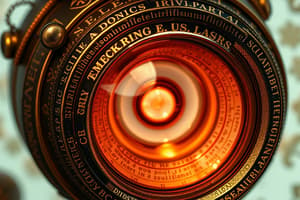Podcast
Questions and Answers
what you look through at the top of the microscope. Typically, standard eyepieces have a magnifying power of 10x. Optional eyepieces of varying powers are available, typically from 5x-30x.
what you look through at the top of the microscope. Typically, standard eyepieces have a magnifying power of 10x. Optional eyepieces of varying powers are available, typically from 5x-30x.
Eyepiece or ocular lens
holds the eyepieces in place above the objective lens. Binocular microscope heads typically incorporate a diopter adjustment ring that allows for the possible inconsistencies of our eyesight in one or both eyes.
holds the eyepieces in place above the objective lens. Binocular microscope heads typically incorporate a diopter adjustment ring that allows for the possible inconsistencies of our eyesight in one or both eyes.
Tube
are the primary optical lenses on a microscope. They range from 4x-100x and typically, include, three, four or five on lens on most microscopes. Objectives can be forward or rear-facing.
are the primary optical lenses on a microscope. They range from 4x-100x and typically, include, three, four or five on lens on most microscopes. Objectives can be forward or rear-facing.
objective lenses
houses the objectives. The objectives are exposed and are mounted on a rotating turret so that different objectives can be conveniently selected.
houses the objectives. The objectives are exposed and are mounted on a rotating turret so that different objectives can be conveniently selected.
are used to focus the microscope. Increasingly, they are coaxial knobs - that is to say they are built on the same axis with the fine focus knob on the outside.
are used to focus the microscope. Increasingly, they are coaxial knobs - that is to say they are built on the same axis with the fine focus knob on the outside.
where the specimen to be viewed is placed. it is used when working at higher magnifications where delicate movements of the specimen slide are required.
where the specimen to be viewed is placed. it is used when working at higher magnifications where delicate movements of the specimen slide are required.
to hold the slide at place
to hold the slide at place
the light source for a microscope, typically located in the base of the microscope. Most light microscopes use low voltage, halogen bulbs with continuous variable lighting control located within the base.
the light source for a microscope, typically located in the base of the microscope. Most light microscopes use low voltage, halogen bulbs with continuous variable lighting control located within the base.
is used to collect and focus the light from the illuminator on to the specimen.
is used to collect and focus the light from the illuminator on to the specimen.
to control the amount of light coming from the illuminator
to control the amount of light coming from the illuminator
This large knob moves the stage up and down in large increments, allowing you to quickly focus on the specimen.
This large knob moves the stage up and down in large increments, allowing you to quickly focus on the specimen.
makes fine adjustments to the stage height, enabling you to achieve precise focus.
makes fine adjustments to the stage height, enabling you to achieve precise focus.
onnects the base to the stage and tube, providing structural support and allowing for easy carrying.
onnects the base to the stage and tube, providing structural support and allowing for easy carrying.
an instrument widely used to magnify and resolve the image of an object that is otherwise invisible to naked eye.
an instrument widely used to magnify and resolve the image of an object that is otherwise invisible to naked eye.
Flashcards are hidden until you start studying
Study Notes
Microscope Components and Functions
- Standard eyepieces generally possess a magnifying power of 10x, with optional eyepieces ranging from 5x to 30x.
- Binocular microscope heads frequently feature a diopter adjustment ring for compensating input differences between each eye.
- Objective lenses are the primary optical components, typically with magnifications between 4x and 100x, with common configurations having three, four, or five objectives.
- Objective lenses can be positioned either forward or rear-facing and are mounted on a rotating turret for easy selection.
- The stage is where specimens are placed for examination, and it is essential for aligning samples under the lens.
Focusing Mechanisms
- Coaxial focusing knobs are becoming standard, enabling simultaneous adjustments of coarse and fine focus.
- Coarse focus knobs allow for large adjustments to the stage height for quick alignment, while fine focus knobs provide minute adjustments for precise focusing.
Light and Illumination
- Microscopes utilize halogen bulbs for illumination, typically located at the base, providing variable lighting control.
- A condenser is employed to collect and focus light from the illuminator onto the specimen, enhancing image clarity.
- An aperture diaphragm controls the intensity of light entering the optical path, allowing adjustments based on the specimen observed.
Structural Components
- The microscope’s structure connects the base to the stage and tube, facilitating stability and portability during use.
- The entire instrument serves to magnify and resolve details of objects that cannot be seen with the naked eye, making it essential for various scientific investigations.
Studying That Suits You
Use AI to generate personalized quizzes and flashcards to suit your learning preferences.



